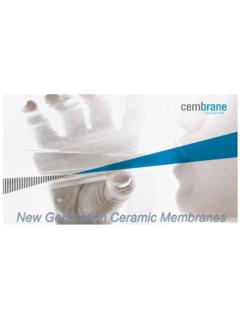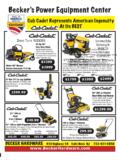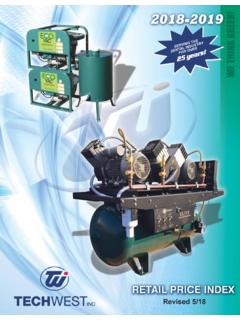Transcription of Carbon and Sulfur Determination— LECO …
1 209-141-001 8/07 REV2 LECO is a registered trademark of LECO Corporation 1 Carbon and Sulfur determination LECO Induction Furnace Instruments 209-141-001 8/07 REV2 LECO is a registered trademark of LECO Corporation 2 Table of Contents General Overview ..3 Ceramic Crucibles and Covers ..5 Analytical Considerations ..5 Detection Capability (instrumental) ..6 Oxygen (combustion and carrier gas) ..6 Ceramic Crucibles ..6 Sampling and Sample Accuracy/ LECO Calibration 11 Analyte Recovery and Related 11 Water and Sulfur Recovery .. 12 Organic 13 Other Problematic Materials .. 13 Reactive Materials.
2 13 Materials Causing Sulfur Recovery Problems .. 13 Analytical Procedures and Special Applications .. 14 Steel and Iron .. 14 Cast 14 Nickel and Cobalt Base .. 15 Refractory or Reactive Metals .. 15 16 Copper Base .. 16 Battery Materials .. 16 Metal Bearing Ores and Related 17 Soil, Clay, and Rock .. 17 Aluminum Base .. 17 Ferroalloys .. 18 Mold 18 18 Limestone, Dolomite, Burnt Lime and Burnt Dolomite .. 19 Cement and Fly Ash .. 19 Ceramics, Sand and 19 Cracking Catalysts .. 19 Abbreviations .. 20 Glossary of Terms .. 21 Appendix A Comparison of Sample Prep Techniques .. 22 Conclusions and Recommendations.
3 27 Application Notes .. 28 209-141-001 8/07 REV2 LECO is a registered trademark of LECO Corporation 3 Carbon and Sulfur determination LECO Induction Furnace Instruments General Overview The majority of metals and their alloys will burn in oxygen if heated to a high enough temperature. The Carbon in the sample is oxidized to Carbon dioxide (CO2) while the Sulfur is converted to Sulfur dioxide (SO2). CO2 and SO2 can then be measured by infrared (IR) detectors. Early combustion methods utilized the resistance heated furnace, but by the mid-1900s it had been replaced by the high frequency (HF) induction heated furnace for increased speed and accuracy.
4 Often, combustion of inorganic materials can be hastened through the use of an accelerator. The purpose of the accelerator is to ignite or set fire to the sample. It can also double as a flux to dissolve any oxide skins making the melt thoroughly fluid. A completely fluid melt is essential in order to oxidize the Carbon and Sulfur in the sample in a relatively short time frame. The use of an induction furnace is the preferred method of heating and combusting metals for Carbon and Sulfur analysis. In an induction furnace, induced electrical currents heat the sample and accelerator; this transfer of power is commonly referred to as coupling with the electric field.
5 Most metals couple well; however, most oxides do not. As combustion proceeds and the metals are transformed to oxides, the combustion temperature will drop significantly resulting in poor recovery. Certain metals such as copper and iron, as well as their oxides, will couple in an HF furnace thereby maintaining sufficient temperature to permit complete oxidation of the Carbon and Sulfur present in a sample. Accelerators Several metals have been used as accelerators over the years, however only a few have been adopted for routine use. Certain advantages are found with each accelerator and in many cases they are combined for optimum performance.
6 When analyzing nonconductive materials such as ceramics and many other nonferrous samples, the use of an accelerator with good inductive capabilities, such as iron, is essential. Following is a description of various accelerators commonly used on an induction furnace. Accelerator Application Copper Chip Excellent accelerator/flux for Carbon determination (particularly in ultra low Carbon determination ) in steel, nonferrous metals and alloys. Usually combined with iron chip when nonferrous materials are analyzed. Copper accelerator is normally not recommended for Sulfur determination in ferrous materials, but it can be used for Sulfur determination using the low temperature technique described in the Analytical Procedures and Special Applications (Copper base, page 16) section of this document.
7 Iron Chip Used for both Carbon and Sulfur determination in some ferroalloys as well as nonferrous materials. Usually combined with tungsten, copper, or tin accelerators. Tungsten Good accelerator for plain Carbon steels providing excellent combustion characteristics when combined with tin. Tin Typically used as an additive to tungsten, copper and iron. Burns readily producing a lot of heat. It can lower the liquidus temperature of the melt. 209-141-001 8/07 REV2 LECO is a registered trademark of LECO Corporation 4 Accelerator Application Vanadium Pentoxide Excellent accelerator for difficult to burn materials.
8 It will produce very high combustion temperatures while also contributing oxygen to the combustion process. It may be used in conjunction with tungsten metal. LECO supplies a variety of high purity accelerators for use in induction furnace Carbon and Sulfur determinators. Following is a description of the most commonly used accelerators. Part No. Description Application(s) 501-263 Copper Chip, -20 to +30 mesh General use in Carbon determination . 502-492 High Purity Copper Chip, -20 to +30 mesh High purity copper for low Carbon determination . 501-457 Tin Coated Copper Chip, -20 to +30 mesh Carbon determination for hard to burn samples such as materials containing refractory carbides.
9 501-076 Tin Metal, -20 to +30 mesh General application, typically used with tungsten, iron or copper accelerators. 501-077 Iron Chip, -6 to +20 mesh General application, typically used with tungsten or tungsten/tin accelerators. 502-231 High Purity Iron Chip, -6 to +20 mesh Ultra low Carbon and Sulfur determination ; lower and more consistent blanks than the 501-077 accelerator. 501-078 Low Sulfur Iron Powder Low Sulfur determination on LECO iodate titrators. Normally not used for Carbon determination due to higher Carbon content of this accelerator. 763-266 Lecocel, -20 to +40 mesh tungsten metal Carbon and Sulfur determination of plain Carbon steels.
10 Can be used in conjunction with iron or other accelerators when nonferrous and/or poor coupling materials are analyzed. 763-263 Lecocel III, -12 to +20 mesh tungsten metal Carbon and Sulfur determination in plain Carbon steels and copper base materials. This was the original Lecocel used on older LECO induction furnace instruments. Its coarser mesh will couple better on lower frequency HF furnaces. 501-008 Lecocel II, -12 to +40 mesh tungsten/tin mixture General application in Carbon and Sulfur determination for steel alloys and nickel and cobalt base alloys. Can be used in conjunction with iron chip accelerator for nonferrous or hard to burn materials.





